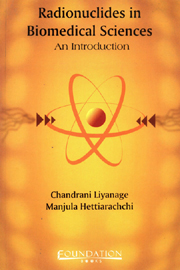Book contents
- Frontmatter
- Contents
- Forewords
- Introduction
- 1 Atomic and Nuclear Structure
- 2 Radiation Detectors
- 3 Units of Radiation Measurements
- 4 Iodine–125
- 5 Radioimmunoassay
- 6 Quality Control in RIA
- 7 Radiolabelled Compounds
- 8 Radiation Safety
- 9 Radiation Protection
- 10 Background Radiation
- 11 Storage
- 12 Contamination
- 13 Radioactive Waste
- References
9 - Radiation Protection
Published online by Cambridge University Press: 26 October 2011
- Frontmatter
- Contents
- Forewords
- Introduction
- 1 Atomic and Nuclear Structure
- 2 Radiation Detectors
- 3 Units of Radiation Measurements
- 4 Iodine–125
- 5 Radioimmunoassay
- 6 Quality Control in RIA
- 7 Radiolabelled Compounds
- 8 Radiation Safety
- 9 Radiation Protection
- 10 Background Radiation
- 11 Storage
- 12 Contamination
- 13 Radioactive Waste
- References
Summary
PRINCIPLES OF RADIATION PROTECTION
On the recommendation of the International Commission on Radiation Protection (ICRP), Basic Safety Standards have been formulated considering the present knowledge of biologically deleterious effects of ionizing radiations on living beings, especially on human beings. The main objective of these standards is to provide guidance for the protection of human beings from undue risks of harmful effects of ionizing radiation, and yet allow beneficial practices involving exposure to radiation. Ionizing radiation is the electromagnetic radiation (e.g., X-ray or gamma ray photons) or corpuscular radiation capable of producing ionization in its passage through matter. Any exposure to ionizing radiation could result from two sources: external exposure from sources outside the body and internal exposure from sources inside the body.
The process of ionization necessarily changes atoms and molecules, at least transiently, and may thus sometimes damage cells. If cellular damage does occur, and it is not adequately repaired, it may prevent the cell from surviving or reproducing, or it may result in a viable but modified cell. The two outcomes have profoundly different implications for the organism as a whole.
Most organs and tissues of the body are unaffected by the loss of even substantial number of cells, but if the number lost is large enough, there will be observable harm reflecting a loss of tissue function. The probability of causing observable harm will be zero (0) at small doses, but above some level of dose (the threshold) will increase steeply to one (100%). Above the threshold, the severity of the harm will also increase with dose. This type of effect, previously called ‘non-stochastic’ is now called ‘deterministic’ by the ICRP.
- Type
- Chapter
- Information
- Radionuclides in Biomedical SciencesAn Introduction, pp. 98 - 102Publisher: Foundation BooksPrint publication year: 2008

